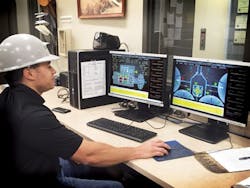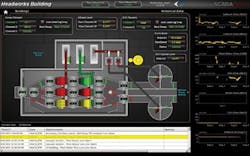About the author: Joshua Niemi is project engineer for SCADAware. Niemi can be reached at [email protected] or 309.665.0135.
The Springfield Metro Sanitary District (SMSD) serves more than 150,000 people in the Springfield, Ill., metropolitan area, including the communities of Chatham, Grandview, Jerome, Leland Grove, Rochester, Sherman and Southern View. The district considered replacing both its Spring Creek and Sugar Creek facilities for three reasons: growth, regulations and age.
Population had grown over the years, and the district’s service area grew as well, taking in neighboring communities. This growth was taxing the plants. At Spring Creek, the average annual flow had exceeded the design average flow capacity of 20 million gal per day (mgd) since 2004. While the Sugar Creek plant had not exceeded the annual design flow of 10 mgd, monthly average flow often surpassed that amount. Both plants were operating in excess of their organic and solids design capacities.
Environmental regulations also had changed. New incentives were created to meet the increasing challenges of cleaning up the Gulf of Mexico dead zone (hypoxic zone), where oxygen levels are too low to support marine life. Communities along the Mississippi River were being asked to reduce discharge. Meeting those demands required new technology.
Lastly, SMSD’s plants were aging. The Sugar Creek facility, the newer of the two plants, was built in 1973. Spring Creek, the original plant, was built in 1928 and had been modified in the 1950s, 1970s and 1990s in an attempt to update the facility.
SMSD believed that modern automation technology could help it operate a larger, smarter and more efficient wastewater treatment plant. Engineering firm Crawford, Murphy & Tilly (CMT)—SMSD’s project manager and lead designer—knew that having a control system integrator as part of its professional services team would ensure that SMSD’s automation goals were met.
CMT had hired system integrators before, but this was the first time it involved one from the beginning of the project. CMT already had planned to use the Wonderware platform as the plant’s SCADA software. Using a list of Wonderware-certified firms, and through online research, CMT narrowed down its list and used its Quality Based Selection to interview prospective firms. CMT chose SCADAware, a specialized control system integration company, due to its experience in SCADA system design and development and its expertise in cross-industry and cross-automation platforms, as well as its nonpareil service standards. SCADAware is a member of the Control System Integrators Assn.
SMSD’s SCADA system controls process equipment, monitors OEM equipment and processes, records process data, and provides alarming for fault conditions.
Building a Smart Plant
When SMSD’s board of trustees decided to move forward with building the new facilities, it directed management to incorporate technology to build a smarter plant. SMSD management and the board planned to double the plant’s capacity without requiring an increase in staff and operational costs. That challenge would require the latest treatment and automation technologies.
The first of the two plants to be rebuilt was Spring Creek, an 80-mgd treatment plant with 40 mgd of storm overflow.
Delivering the System
SCADAware’s role in the project was to deliver the complete SCADA system. Initially, the company provided preliminary engineering assistance to CMT in preparation for the bid and construction documents. After the preliminary stage, the scope of services included the SCADA system design engineering, implementation, in-house testing, factory acceptance test (FAT), onsite startup, documentation, and closeout/training. It also completed all panel design and fabrication. The final panel design was provided to the electrical contractor prior to construction, including a detailed panel layout, a detailed list of materials and complete I/O wiring diagrams.
SCADAware provided dedicated project managers to co-manage the project and participated in regular project status meetings with CMT and SMSD. With early involvement, it was able to understand SMSD’s efficiency, monitoring and control goals, and give guidance on how to achieve them.
New wastewater treatment facilities consist of equipment from various manufacturers. Coordinating communications between these suppliers’ equipment and establishing programming standards are priorities of the Wonderware system.
During the design phase, the company designed the Profibus-DP device network, which interfaces with the monitor control centers, gate actuators, chemical analyzers and other sensors. It also designed the Ethernet fiber ring, which provides site-wide fault-tolerant network redundancy for the plant’s programmable logic controllers (PLCs), SCADA servers and operator workstations.
SCADAware developed the software and associated hardware architecture, plant process control sequence of operations and SCADA/HMI operator interface. These design documents were used to create a detailed functional specification document to be used for preliminary SCADA design meetings with CMT and SMSD.
Working with SMSD plant personnel and CMT engineers, SCADAware’s programmers developed an efficient control sequence. A FAT was successfully conducted at the company’s home office. SCADAware then programmed the plant’s PLCs to follow the tested control sequence, utilizing Ethernet communication to OEM systems. The finalized functional specification then served as a guideline by which SCADAware’s programmers developed the SCADA and control systems for the wastewater treatment facility at SMSD. The specification document was as comprehensive as possible so the system could be configured without much additional information during the development phase.
SCADA at SMSD
The SCADA system at SMSD functions primarily to control process equipment, monitor OEM equipment and processes, record process data, and provide alarming for fault conditions. Alarms are categorized by severity, giving the system the flexibility to self-correct for out-of-bounds process conditions before escalating the situation to an after-hours alarm call. The system annunciates alarm conditions through the SCADA screens and also provides telephone alarms through a software alarm dialer that will function during hours when the plant is not manned.
SMSD’s SCADA system monitors approximately 20,000 data points, including information from the remote terminal units at the district’s 32 lift stations and more than 50 PLCs. System users include plant operations and supervisory personnel. Operators interface with the SCADA system through the main operator station in the control room and can control the system through industrial PC panels in process buildings.
The new SCADA system helps to:
- Use labor efficiently. SMSD runs a crew of seven operators and two head operators for the first two shifts. The SCADA system runs the third shift. The plant would have required an operating crew of 28 to 30 under the old system.
- Empower operators. It no longer is too costly for operators to collect large amounts of data for a “just-in-case” scenario. Now, they can build reports with a few clicks.
- Report effectively. The SCADA system automatically generates reports at the end of each month, making reporting to the U.S. Environmental Protection Agency (EPA), Illinois EPA, and SMSD’s trustees simple. Once a day, it reports on dissolved oxygen levels for water entering the receiving stream, the Sangamon River. The system also reports on statistics for all process meters.
- Track maintenance accurately. All data are stored in a database that can be accessed at any time. Maintenance-related data are pushed from the SCADA system to the plant’s maintenance system.
- Save energy. SMSD is running a plant double its original size, but with a slightly lower yearly energy bill.
- Monitor and notify. Plant supervisors can remotely monitor the entire system. Their cell phones allow them to remotely access and acknowledge any system alarms.
- Provide support. SCADAware has an ongoing support and service contract with SMSD. Using SMSD’s administrative network, SCADAware is able to log in to a terminal server on the plant network to diagnose and correct any problems with the SCADA system.
“From an operational standpoint, our challenge in building a new facility which would double our capacity was to find a way to get it done without simply doubling everything—labor, energy cost, etc.,” said Brian Tucker, operations supervisor for SMSD. “We needed to build a smarter plant. SCADAware’s expertise in SCADA systems and integrating many different types of technologies exceeded our expectations of what we could accomplish.”

